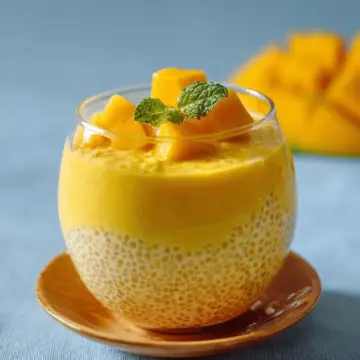Introduction to Mango Sago
What is Mango Sago and Why Try It?
Mango Sago is a delightful, tropical dessert that hails from Singapore and other parts of Asia. It combines luscious mangoes with small, chewy tapioca pearls immersed in creamy coconut milk, creating a flavor explosion that is both refreshing and indulgent. Perfect for hot summer days, this dish is not just a feast for the palate but also visually stunning. Who wouldn't love a bowl of bright yellow goodness topped with fresh mango chunks?
Why should you try Mango Sago? For starters, it’s incredibly easy to make at home! In under an hour, you can whip up this gorgeous dessert that’s sure to impress friends and family alike. It's also versatile; adjust the sweetness to your liking or even add a splash of fruit juice for a twist. Plus, with health benefits from mango and tapioca, this treat can fit into a balanced diet.
If you're interested in exploring Asian desserts, Mango Sago is a fantastic entry point. It brings flavors you might not have experienced before while being simple enough for even beginner cooks. Curious to learn how to create this delicious dessert at home? Keep reading for the full recipe and tips on perfecting your Mango Sago experience!

Ingredients for Mango Sago
Essential ingredients for the perfect Mango Sago
To whip up this delightful Mango Sago, you’ll need just a few standout ingredients that work harmoniously to create a refreshing dessert. Here’s what you must include:
- ½ cup uncooked small-sized tapioca: This creates that delightful chewy texture we crave.
- 3 ripe mangos: Opt for the juiciest ones to ensure your dessert bursts with flavor.
- 200 ml unsweetened coconut milk: This gives your Mango Sago a rich creaminess without overpowering the mango’s sweetness.
- 60 ml sweetened condensed milk: This sweetens the dish; feel free to adjust according to your taste.
- ½ teaspoon vanilla extract: A splash of vanilla enhances the overall flavor and aroma.
Optional ingredients to customize your dessert
Want to put your spin on the classic Mango Sago? Here are some optional ingredients you might consider:
- Fresh mint leaves: For a refreshing garnish, adding a pop of color and flavor.
- Chia seeds: Boost the health benefits and add an interesting texture.
- Additional fruits: Consider diced papaya or kiwi for added tropical flair.
- Serving bowls: Using cute, decorative bowls can elevate the presentation and make your dessert even more appealing.
With these ingredients in hand, you're ready to take on the challenge of making this crowd-pleaser! For more exciting variations, check out this article that dives deeper into Mango Sago twists.
Preparing Mango Sago
Creating a delightful Mango Sago at home is easier than you might think! This refreshing dessert is perfect for summer gatherings or a simple treat to enjoy at home. Let’s walk through the steps to prepare this tasty dish, ensuring you’ll impress your friends and family with your culinary skills.
Cook the Tapioca Pearls
Start by boiling your tapioca pearls, essential for that chewy texture that defines Mango Sago. Bring 4 cups of water to a rolling boil in a medium-sized pot. Carefully add ½ cup of small-sized uncooked tapioca pearls. Give it a good stir and bring it back to a boil. Lower the heat, and let it simmer for about 20 minutes or until the pearls turn completely transparent. If you find any white centers after this time, cover the pot and let them sit in the hot water for an additional 10 minutes.
Once the tapioca is cooked, drain and rinse them in cold water to halt the cooking process. Then, soak them in a bowl of cold water while you prepare the mangoes. This not only cools them down but also helps maintain their texture.
Prepare the Mangoes
Now, let’s dive into the star of the dessert—the mangoes! Choose three ripe mangos, as their sweetness will elevate the Mango Sago to whole new levels. Peel and slice the mangos, removing the pit carefully. Remember to save a handful of nice chunks for garnishing later; this adds a lovely texture and visual appeal. With the rest of your mango, we’ll move on to creating a smooth, fruity blend.
Blend the Mango Mixture
In your blender, combine the sliced mango (minus the chunks you set aside), 200 ml of unsweetened coconut milk, 60 ml of sweetened condensed milk, and ½ teaspoon of vanilla extract. Blend on high until the mixture is silky smooth. If you're a fan of cold desserts, make sure to chill this mixture for at least an hour—this allows the flavors to meld deliciously!
Combine Tapioca with Mango Mixture
When you’re ready to assemble your Mango Sago, it’s time for the magic to happen. Drain the soaked tapioca pearls and carefully fold them into the chilled mango mixture. The contrast of the chewy pearls with the smooth blend is simply irresistible!
Chill and Serve
Finally, scoop your Mango Sago into individual bowls. Top each serving with those beautiful mango chunks you saved earlier. If you thrive on presentation, why not add a sprig of mint or a sprinkle of shredded coconut? For an even cooler treat, you can pop it back in the fridge for a bit longer before serving.
This dessert truly encapsulates summer and brings a taste of the tropics to your table! For a deeper dive into mango varieties and their nutritional benefits, check out Healthline. Enjoy your creamy, fruity creation!

Variations on Mango Sago
Add-ins for a twist on traditional Mango Sago
If you’re looking to elevate your Mango Sago, consider adding in ingredients like toasted coconut flakes, chia seeds, or even a scoop of vanilla ice cream for a creamy contrast. You can also try mixing in a drizzle of passion fruit puree or a splash of lime juice for a zesty kick! Each of these add-ins brings a unique twist that keeps your dessert fresh and exciting.
Alternative fruits for seasonal variations
Flexibility is the beauty of this recipe. Don’t hesitate to swap out the mango for seasonal fruits! Think ripe strawberries in spring, sweet peaches in summer, or even warm spiced apples in fall. You can create delightful combinations, like Mango Sago paired with pineapple or berries for a colorful and flavorful experience. Explore endless possibilities and let your taste buds guide you!
Cooking notes for Mango Sago
Tips for choosing ripe mangoes
When selecting mangoes for your Mango Sago, look for fruit that's slightly soft to the touch with a sweet aroma. Varieties like Honey or Kent are ideal as they balance sweetness and texture beautifully. Avoid any mangoes with dark spots or a sour smell, as these can indicate overripeness. If you want to speed up ripening, simply store them in a paper bag at room temperature!
Troubleshooting tapioca texture issues
Getting the perfect texture for the tapioca in your Mango Sago is essential. If your tapioca ends up gummy, it's likely overcooked. Make sure to follow the cooking times closely and avoid letting it sit in hot water after cooking. If it's too chewy, try soaking it longer in cold water after rinsing. This simple trick helps achieve that delightful, tender texture that complements the creamy mango blend beautifully. For more tips on tapioca, check out Serious Eats.

Serving suggestions for Mango Sago
Creative ways to serve and present Mango Sago
When it comes to serving Mango Sago, presentation can elevate your dessert game! Consider using elegant glassware or mason jars for a chic look. Layering the Mango Sago with fresh mango chunks and a sprinkle of toasted coconut on top creates an eye-catching dessert. For a tropical twist, garnish with a mint leaf or a slice of lime, adding vibrant color and aroma.
Pairing suggestions for a complete dessert experience
To round off your Mango Sago experience, think about pairing it with some delightful accompaniments. Lightly toasted coconut cookies or crisp Asian rice cakes complement the creamy texture beautifully. For a refreshing beverage, serve alongside coconut water or green tea, enhancing the tropical theme. Want more ideas? Swap in your favorite fruits or experiment with flavors—after all, cooking is all about creativity!
Tips for making perfect Mango Sago
Key tips for balancing sweetness
Achieving the perfect Mango Sago involves fine-tuning the sweetness to your liking. Start with a moderate amount of sweetened condensed milk, then gradually adjust. Remember, the ripeness of your mangoes plays a crucial role! Overripe mangoes naturally boost sweetness, so taste as you go. If you find your dessert a bit too sweet, a splash of lime juice can enhance flavors and balance things out.
Storing leftover Mango Sago
If you have any Mango Sago left over (though it's likely to disappear quickly!), store it in an airtight container in the fridge. It'll keep for about 1-2 days. To prevent the tapioca pearls from hardening, give it a gentle stir and add a splash more coconut milk before serving again. For more ideas on tropical desserts, check out this tasty guide here.
Time Details for Mango Sago
Preparation Time
Get ready with your ingredients as you’ll need roughly 10 minutes to prep. This includes peeling the mangoes, measuring your tapioca, and getting everything set up for cooking.
Cooking Time
Once you dive into cooking, this delightful Mango Sago will take around 30 minutes. Most of this time is spent transforming those tiny tapioca pearls into the perfect texture for your dessert.
Total Time
In just 40 minutes, you’ll have a refreshing and satisfying Mango Sago ready to impress! Whether you savor it immediately or let it chill for a bit, it's a delightful treat perfect for any warm day.
Discover how the blend of mango and coconut milk creates a tropical escape right in your kitchen! Interested in learning more about tapioca's origins? Check out this article on the history of tapioca for a fun read!
Nutritional Information for Mango Sago
Calories
A serving of Mango Sago contains approximately 326 calories, making it a relatively light dessert option. This delightful treat offers a sweet escape without a heavy calorie burden, making it a favorite during warm summer days.
Sugar Content
Each serving of Mango Sago has about 32 grams of sugar. While much of this comes naturally from the ripe mangoes, keep in mind that the sweetened condensed milk also contributes to the total. For a healthier version, consider adjusting the amount of condensed milk to suit your taste.
Dietary Considerations
Mango Sago is primarily gluten-free, thanks to its tapioca base. For those following a vegetarian or lactose-free diet, substituting the sweetened condensed milk with a plant-based alternative can tailor the dish to your dietary preferences. Whether you’re enjoying it as a light dessert or a refreshing snack, this dessert can fit into various eating plans.
For more information on the nutritional benefits of mangoes, check out the Mango Board. They highlight the health advantages of incorporating this tropical fruit into your diet!
FAQs about Mango Sago
Can I make Mango Sago ahead of time?
Absolutely! Mango Sago is perfect for preparing in advance. You can make the tapioca and mango mixture a day prior. Just remember to chill it in the fridge after combining the ingredients. When you're ready to serve, simply mix in the soaked tapioca and enjoy!
What can I substitute for coconut milk?
If you're not a fan of coconut milk, you can use alternatives like almond milk or oat milk for a different flavor profile. Both options can give your Mango Sago a unique twist while still keeping it creamy. Just ensure that the milk you choose is unsweetened if you want to control the sweetness!
Is Mango Sago gluten-free?
Yes, Mango Sago is gluten-free, making it a great dessert choice for anyone with gluten intolerance. The main ingredients—tapioca and mango—pose no gluten risks. For further insights on gluten-free options, check out resources like Celiac Disease Foundation.
Conclusion on Mango Sago
The joy of Mango Sago lies in its vibrant flavors and refreshing texture, perfect for any summer day. I encourage you to try this delightful dessert; it’s simple, satisfying, and sure to impress! Dive into this recipe, and let it add a tropical twist to your dessert table.

Mango Sago
Equipment
- pot
- blender
- bowl
Ingredients
Tapioca and Milk Mixture
- 0.5 cup small-sized uncooked tapioca (about 60g)
- 200 ml unsweetened coconut milk (½ of a 13.5 oz. can)
- 60 ml sweetened condensed milk (¼ cup, or more to taste)
- 0.5 teaspoon vanilla extract
Mango
- 3 ripe mangos (about 1 kg)
Instructions
Cooking Tapioca
- In a pot, bring 4 cups of water to a boil. Add the mini pearl tapioca and stir, bringing it to a boil again. Simmer for 20 minutes until fully cooked, then let sit for another 10 minutes if needed.
- When the tapioca is cooked, drain, rinse in cold water, and soak in a bowl of cold water. Set aside.
Preparing Mango Mixture
- Peel and trim the mangos, reserving a handful of chunks for topping. Blend the remaining mango with coconut milk, condensed milk, and vanilla extract until smooth. Chill for at least an hour if desired.
Serving
- When ready to serve, drain the cooked tapioca and mix it with the chilled mango mixture. Scoop into bowls and top with reserved mango chunks.





Leave a Reply